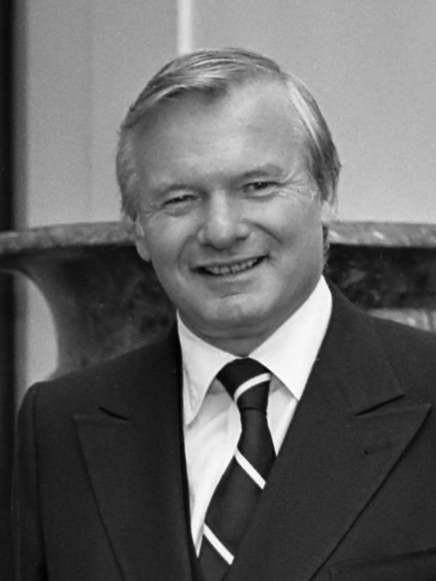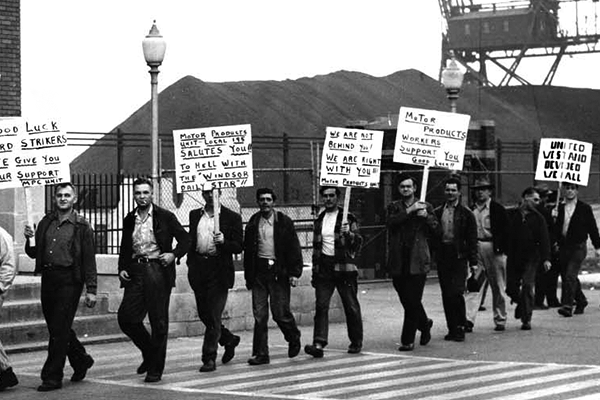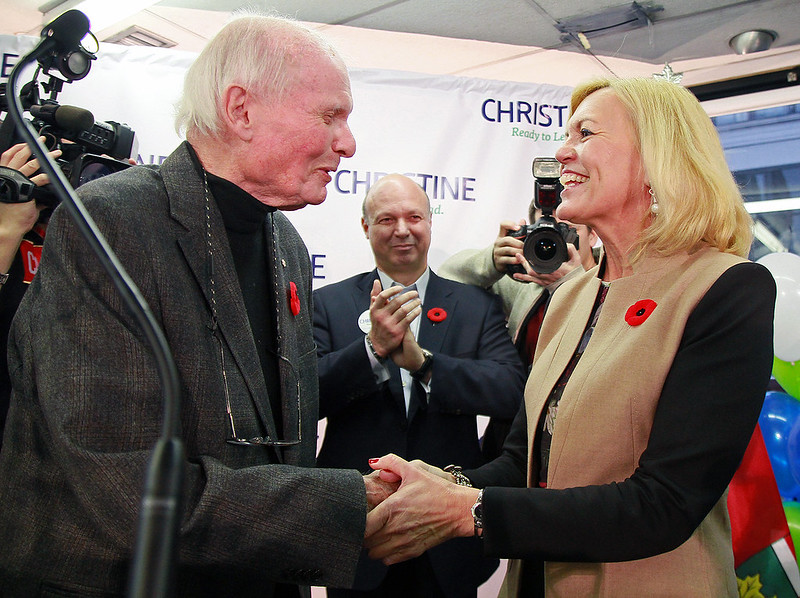
via Wikimedia Commons
The death of former Ontario premier Bill Davis was announced on Aug. 8. His death was met with a round of gushing praise from the political establishment across the board. Even many in the labour movement took the occasion to salute Davis’s “contributions.” We should, however, not be fooled: Bill Davis was no friend of the working class.
From Ontario NDP MPP Chris Glover we’re told past Tory premier Bill Davis “fought for a progressive, fairer & more prosperous Ontario.” At least one former NDP MPP called him a “beautiful man.” Several current and former labour leaders praised Davis similarly.
We got a taste of this when the 2013 death of Davis’s labour minister Bob Elgie prompted then-Ontario Federation of Labour VP Julie Davis to claim Elgie “had a big heart, a big vision.”
Having more of a heart than recent Tory leaders is a low bar. But why are figures in the labour movement praising a stalwart of the Conservative political establishment? The answer lies in the history of Ontario and the role that Davis played within the development of the state apparatus.
Where Bill Davis came from
Davis’ early political activity tells you a lot about where his political allegiances lie. Born in 1929, Davis got involved in right-wing Ontario politics at age 15, as a convention delegate and campaigner for MPP and Agriculture Minister Thomas Kennedy.
Within a decade, the ruling Ontario Liberals were dwindling, strikes were multiplying and the left-wing Cooperative Commonwealth Federation (CCF) was mushrooming. Ahead of Ontario’s 1943 provincial election, the wealthy lined up behind Progressive Conservative Party Leader George Drew. Drew promised his “Big Blue Machine” would defend the “great fellowship that was the British Empire” from “the evil geniuses of socialism” and their “school teacher” supporters.
Drew’s minority government partnered with police to spy on union organizers to inform a broad “anti-socialist” campaign—aided by the Public Information Association. The red-baiting campaign material famously depicted a CCF led by a “Jewish immigrant boy” working with “foreign operatives” to “destroy the Canadian way of life.” With the help of Inco, Massey-Harris, Royal Bank of Canada, and Loblaws, the Tories secured a majority in 1945.
Davis’ mentor, Kennedy, was in cabinet throughout much of this period and became “caretaker premier” after Drew’s exit to federal politics. Kennedy handpicked Davis to replace him in his Peel riding in 1959—seeing in him a potential future premier.
Davis the reformer
Unlike many European countries which had labour/socialist governments take power in the wake of the Second World War, the Conservatives ruled the roost in Ontario for more than 40 years, from 1943-87. While the welfare state throughout Europe was constructed during this period by social democracy in Europe, the same process in Canada occurred under the Liberal party federally and in a strange situation, under the Conservatives in Ontario.
But this wasn’t because the Ontario Conservatives like Bill Davis were simply “better” people than the Conservatives of today—it was primarily due to the economic and political conditions of the time. The destruction of the Second World War and a number of other factors in the post-war period allowed capitalism to overcome the crisis of the 1920s and 1930s and set the stage for unprecedented economic expansion from the late 1940s until the mid-1970s. For example, from 1946-1957, the value of Canada’s total manufacturing output—much of it concentrated in Southern Ontario—nearly doubled. Other sectors experienced similar growth with regular GDP increases of six per cent, accelerating into a “near-record pace of growth” in the early 1970s. On the basis of this consistent profitability, the province’s revenues ballooned.
Ontario’s government, like others, turned towards Keynesian policies of deficit spending to support its industrial expansion and buy social peace. The province’s successive post-war Tory governments intervened to subsidize and otherwise assist nearly every sector: energy, housing construction, manufacturing, transportation, forestry, steel, mining, technology and more. These governments also funded the construction and expansion of highways and expanded and centralized the province’s electricity output through the eventual development of Ontario Hydro and various nuclear sites.
This period also saw Ontario’s governments introduce, albeit tepidly, compulsory education to age 16 in 1954, public health care in the form of the Ontario Medical Services Insurance Plan in 1966, and other programs.
Davis served as education minister starting in 1962, under Premier John Robarts. There, he oversaw the development of TVOntario (TVO), Ontario’s community college network, York, Brock, Trent, and Laurentian universities and the Ontario Institute for Studies in Education. This was among the largest expansion of the education network in the history of the province. This improved the quality of life for many and it saw the public sector workforce expand dramatically. Ultimately, it is this period which leads the liberal Toronto Star and former ONDP leader Stephen Lewis to both emphasize Davis’s “passion for education”.
But, as we’ve explained before, there is nothing inherently “progressive” about Keynesianism and no guarantee those measures that did improve working class living standards would persist. The fact of the matter is that governments in the advanced capitalist countries, whether liberal, conservative or social democratic, all employed Keynesian policies because these were the policies that most suited the interests of capitalism and the ruling class at that time. Keynesian policies of state-run companies and deficit spending were useful to the ruling class and were used to maintain profitability and “regulate” the economy. Even Richard Nixon once said “we are all Keynesians now”.
During the post-war upswing, the state was used as a lever to rebuild industries and invest in new sectors and technologies. The state invested in infrastructure, in public utilities and in economic sectors that were scarcely profitable in the short term. In the 1950s and the 1960s, state-run companies and increased state intervention in the economy were good for profits.
In this period of unprecedented economic growth, the ruling class could afford some reforms. With the pressure of the working class and fearing militant workers’ movements and even revolution, the ruling class in the advanced capitalist countries granted concessions and the welfare state was developed.

However, despite some state spending and the expansion of social services, throughout the 1950s and 1960s, the Tories remained Tories. Enormous sums went directly to big business, especially prominent Tory donors, with little accountability—while special measures were maintained to repress workers. Premier George Drew demanded Ottawa send the army into Windsor to crush the 1945 auto workers’ strike. Through 1946, his government deployed OPP officers against striking dockworkers and others. Frost raised the minimum threshold for union certification, restricted strikes until one week after mandatory arbitration and empowered municipalities to “opt out” of collective bargaining entirely. Robarts imposed further restrictions on public sector workers’ ability to unionize and, in 1966, considered establishing a “labour court” allowing companies to sue unions for strikes, walkouts and boycotts.
Furthermore, across budgets, the Tories stressed they would carefully review every dollar spent and prepare to reverse course should the economic situation change. Their anti-worker policies continued and, indeed, intensified as the upswing ended.
Davis’s early premiership: Budget cuts and more strikebreaking
By 1971, when Davis became premier, the post-war upswing was nearing its end. In Canada and globally, post-war production was expanding faster than the market and successive oil price shocks meant multiple recessions Canada-wide from 1973-1985 as well as inflation. Deficit financing by governments—including in Ontario, which was running record deficits by the end of the 1970s—failed to reverse the trend, largely just creating more inflation. With the oil crisis and the onset of stagflation, the Keynesian policies of the 1950s and 1960s were turning into their opposite. State-owned companies were no longer good for profits, and the welfare state and state expenditure on infrastructure were becoming burdens in terms of profitability. With the class struggle on the rise, the ruling class took the old means of buying social peace off the agenda. Rather than Keynesianism, governments in the advanced capitalist countries began to implement policies of privatization and austerity, as it was these policies that were good for profits.
Davis had been praised by members of the Royal Canadian Yacht Club for making “procrastination a vital and important instrument in the running of a government.” But the new period demanded cutbacks and attacks on working and living conditions.
Early in his tenure, Maclean’s wrote that Davis’ party “consists of old fogies, young fogies and a lot of rich people willing to contribute millions to run the Big Blue Machine.” And, run it they did. Throughout the 1970s, Davis decried the “competitive” advantage of U.S. industry relative to Ontario’s and stated plainly on Oct. 28, 1977: “Part of it is a question of wages; I’m not going to minimize that.” He was also an early and explicit proponent of the federal government’s effort under Pierre Trudeau to cut wages and social programs—secured with comparable attacks on the right to organize and strike. In both cases, Davis was eager to make workers pay for the crisis.
In 1972, strikes by Toronto municipal workers paved the way for Ontario’s Crown Employees Collective Bargaining Act—which granted public sector workers the nominal right to collective bargaining—but this right was practically undone by the fine print. As Donald Carter notes, written into the act was “a complete prohibition against any form of strike action.” The government further designated issues related to classification, merit, performance evaluation and pensions the “exclusive domain of management.”
Soon after, Davis began cutting health and education funding. Before 1970, education funding had increased by an average of 13.1 per cent a year. Some have referred to Davis as the “education premier” because of this funding and the creation of a number of education institutions while he was in office. But Davis as premier didn’t expand education services because he was a “beautiful man” and the Tories in power didn’t invest in education because they had big, “progressive” hearts. Education and other social services were expanded in the 1950s and 1960s firstly because of pressure from the working class, but also because these reforms could be afforded in a period of massive economic upswing. What’s more, an advanced economy with modern technology and industry requires an educated working class. Education services and universities needed to be expanded to meet the needs of capitalism in providing workers that can operate in an advanced economy. Thus, the role played by Davis in the development of Ontario’s education system was in service of the interests of capitalism and the ruling class.
When the economic situation changed and capitalism required a sharp reduction in social spending and the dismantling of the welfare state, Davis remained a loyal servant of the ruling class and implemented the austerity policies required by capitalism. By 1974, the increase in education spending had dropped to below eight per cent, prompting increased class sizes and general deterioration. In 1975, Davis further froze salaries, discharged more than 1,000 employees and contracted out highway maintenance and snow plowing services. All told, from 1975 to 1980, approximately 7,000 public sector jobs were eliminated.
Davis’s finance minister further entertained advice from its Special Program Review for a sweeping $1.6 billion austerity program. The Review suggested the government raise college tuition and cut college courses, “return” medical insurance to the private sector, lay off health-care staff and massively increase Ontario Hospital Insurance Plan (OHIP) premiums. The government also began looking to tighten social assistance eligibility, limit “welfare dependency” and kick off “welfare parents.” Among the review’s suggestions, according to the opposition, was a policy to, as The Globe and Mail noted on Nov. 21, 1975, have welfare recipients “sterilized or excluded from the welfare system.”
Davis appointed his successor, Frank Miller, to close hospital facilities, beds and health labs soon after. By 1980, southern Ontario’s hospitals had only 3.5 acute care beds per 1000 people—the lowest in the country, before funding was cut further.
These cuts prompted a number of confrontations throughout the decade.

As teachers lacked the legal right to strike, they had previously resorted to “mass resignations” as a form of protest. Through the fall of 1973, teachers across nearly 17 different school boards all threatened mass resignations in response to government cuts. But on Dec. 10, 1973, Davis’s Tories tabled a bill to make these resignations illegal, initially with the support of the Liberals. When the Liberals rescinded their support, Davis complained of their “lack of intestinal fortitude” but ploughed ahead. The legislation was eventually defeated by an unlawful strike and mass rallies.
In 1974, during the Toronto Exhibition, TTC drivers struck against grueling 13-hour shifts and management’s attempt to casualize their work. Davis legislated them back to work, with votes from the Liberals.
With nothing settled, in 1978 the TTC workers were back on strike. Again, Davis introduced strikebreaking legislation to bring them to heel, telling the legislature: “We decided that the issue was not going to be resolved through the normal collective bargaining process.”
By 1980, Ontario was among the only jurisdictions in North America to deny non-medical hospital workers the right to strike. When 16,000 workers at 50 hospitals struck against low wages and gruelling workloads, the response was 35 firings, 3,500 suspensions and 5,600 disciplinary letters. When they were supported by the Canadian Union of Public Employees, Davis’ government responded by jailing union representatives. Confronted by angry workers in Sudbury, Davis was unapologetic, promising that “as long as I’m premier, the law will be maintained.”
Paring workers ‘to the bone’
Through the 1980s, Davis further attacked workers and planned even deeper cuts.
Effective Sept. 21, 1982, Davis’s Inflation Restraint Act extended all collective agreements by one year, suspended public sector workers’ right to strike and capped wage increases at five per cent, against the highest inflation in 33 years. This regressive policy was intended, according to the subsequent budget, to spare the business owners “unwarranted growth in public expenditures.” In 1983, Davis introduced the Public Sector Prices and Compensation Review Act which subjected all collective agreements to review by a “Restraint Board” mandated to consider employers’ “ability to pay in light of existing fiscal policy.” In May 1984, the government amended the Labour Relations Act as “Bill 75” to allow for stiff penalties against anyone involved in a strike deemed unlawful, including rank and file members and community supporters. All told, by 1985 Davis’ anti-union legislation was considered so extensive that the International Labour Organization ruled his government violated “fundamental” trade union freedoms.
By the time Davis resigned, it was clear more cuts were coming. Author Rosemary Speirs notes in her book Out Of The Blue that a leaked internal memo from Davis instructed ministers to “pare” transfers to fund schools and hospitals “to the bone” through 1985.
Media reports subsequently found Davis had promised the government’s bondholders in New York that his government would impose “strict restraint” on the public sector to maintain the province’s credit rating.
After the premiership
However, even after stepping down as premier, Davis’s shadow loomed large over the province.
Patrick Monahan notes in his account of Bob Rae’s NDP government that, well into the 1990s, much of the state bureaucracy, especially within the Ministry of Labour, was unchanged from the Davis years. Liberal journalist Thomas Walkom observed similarly: “In Ontario, four decades of Tory rule had so blurred the distinction between partisan politics and sound administration that the civil service of the cabinet office ended up doing both.”
Through the Rae period, this bureaucracy asserted itself with regular leaks to right-wing media and with “suggestions” for dealing with the province’s unions. On the whole, Monahan argued: “the civil servants’ agenda, more often than not, was identical to the business agenda.”
When the Rae government faced a deep economic slump, the bureaucracy eagerly reviewed the Davis’ government’s 1970s and 1980s “wage control” programs—the same ones the NDP campaigned against—for cost-cutting models.
When the Rae government introduced its so-called “Social Contract”, tearing up collective agreements and forcing workers to take unpaid days off, Davis himself was not far.
The past premier personally phoned Rae to congratulate him, saying: “You’ve done more to restructure that aspect of provincial spending than anybody, including me.” According to Rae, Davis—then sitting on “a number of corporate boards”—was eager to “mentor” the government through successive austerity budgets which saw tuition fees balloon, hospital beds close and social assistance rates frozen.
Davis and the ‘Common Sense Revolution’

via Wikimedia Commons
Following Davis’s resignation and Miller’s defeat, the Tories were split between an “Albany Club” wing and a more ideological right wing. The latter was represented, as journalist Christina Blizzard notes, by then-MPPs Mike Harris, Tom Long, Tony Clement, David Lindsay and others. All of them would become key members of the Harris campaign and his inner circle. Almost without exception, each owed their political origins to Davis.
From 1992-93, Harris further leaned on Tory insiders from the Davis period to set up over 50 private dinners with, as Blizzard describes them, “the movers and shakers and corporate elite of Bay Street” to secure campaign funds and to help draft his platform.
In power, Harris was more ideological about his attacks on the working class and the poor. He cut public spending by $1.9 billion—half of it from social assistance and the rest from hospitals, schools, transit and basic health and safety safeguards. The result was a spike in homelessness, hospital and school closures and prominent disasters like the Walkerton tragedy.
But, as journalist John Ibbitson notes, Davis remained a party supporter throughout, even if he occasionally expressed discomfort with its many confrontations. Davis endorsed Harris’ “Common Sense Manifesto”, something Harris used to promote his candidacy. Davis also joined Harris at campaign rallies, at the opening of the legislature in 1995 and at the Empire Club in 1999. More importantly, TVO anchor Steve Paikin notes Davis was kept abreast of cabinet decisions often before some MPPs themselves. He continued to meet with subsequent Progressive Conservative Party leaders after Harris resigned and after the Tories were turfed from office.
Nostalgia for the status quo
According to the Toronto Star, Davis deserves credit for having “ushered in Ontario’s modern era”—an era marked by underfunded hospitals, schools in disrepair, enormous restrictions on the right of workers to organize and more.
When the economy was booming and the system could afford reforms, maintaining the status quo often meant reluctantly introducing social programs and providing occasional wage increases. In virtually every case, these programs were bound up with new anti-worker restrictions and plans to rein in spending. Following the end of the post-war upswing in the 1970s, these restrictions intensified and Davis inaugurated them as premier with anti-worker legislation and budget cuts. At all times, whether employing some Keynesian-style reforms or later implementing austerity, Davis was a faithful representative of the ruling class who implemented the policies that met the interests of the capitalist system.
It is not particularly surprising to see Liberal and Tory politicians express admiration for Davis as a pioneer of their own regressive politics. It is, however, more distressing to see some associated with the labour movement, who claim to oppose job cuts, wage freezes, school closures and more, do the same. That road truly offers no alternative.
Some on the left and leaders in the trade union movement are looking back on Davis’ record with rose-tinted glasses. In comparison with Tory leaders today whose sole mantra is austerity with cuts, more cuts, and even more cuts, they have tended to see only what they want to see. The focus in the media is on Davis’s Keynesian policies, which were not unusual for the time and were implemented by pretty much all governments of the era. There is nothing inherently left-wing or progressive about these policies. In focusing on this aspect of Davis, those on the left praising him have forgotten his draconian anti-worker policies, his policies of austerity, and his attacks on living and working conditions. Davis was a faithful representative of the ruling class. This cannot be forgotten. We must reject any nostalgia for “progressive” right-wingers of the past.
For some on the left and in the trade unions, there is a longing for the “good old days” of state spending, the expansion of social services, and the creation of the welfare state. Many in the NDP, for example, would like to return to an era of Keynesian policies and expanding social services like in the 1950s and the 1960s. This is perhaps why they praise Bill Davis, as he was closely associated with government policies for a number of decades throughout this era.

But these policies were only possible on the basis of the greatest economic upswing in history. A return to such policies and that era is not possible today with the greatest economic crisis in history unfolding before our eyes. Besides, such policies would not solve the current crisis and could never be sustained.
Rather than looking back with nostalgia at bygone eras that will not return, the left should be focused on preparing for the future. The problem isn’t just a question of how much the state should spend on this or that social service, but a fundamental crisis of the capitalist system itself. We should be preparing for the explosions in the class struggle that will inevitably erupt. The question before us is not “Keynesianism or austerity?” but “socialism or barbarism?”. Knowing our class enemies will help us prepare for these future struggles, and Bill Davis was an enemy of working people.

